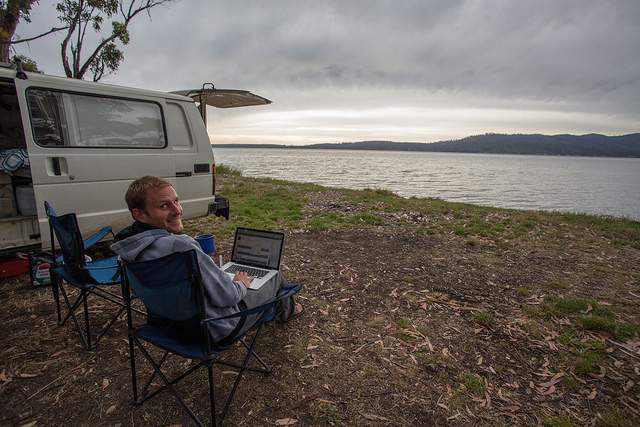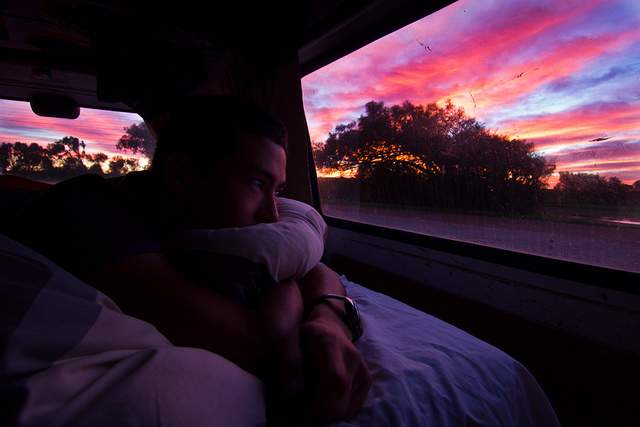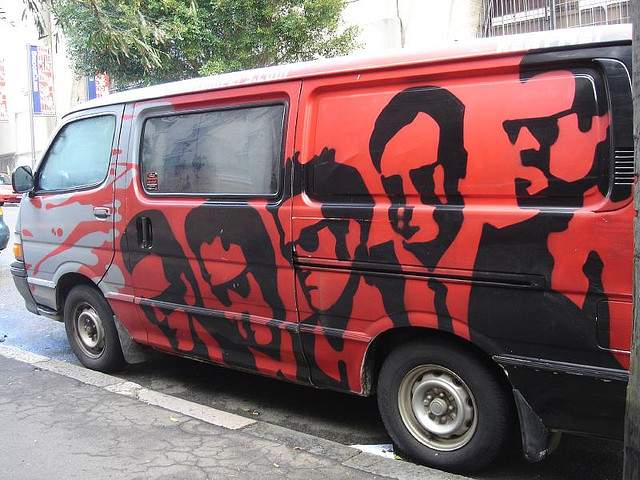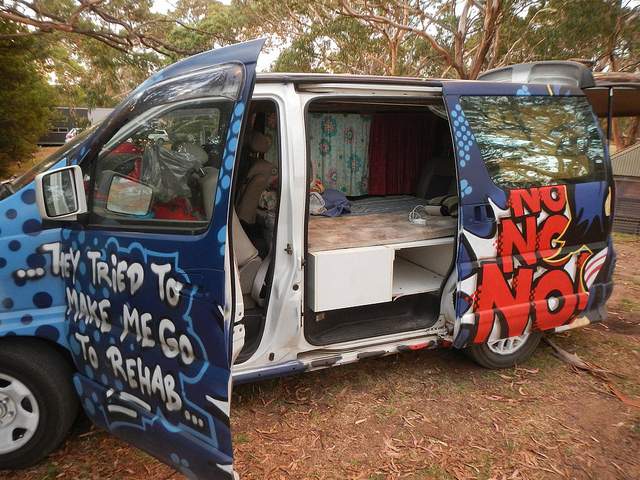Australia: Vast expanses of red earth, broken and furrowed by the constant hammering of an unforgiving sun. Images of engulfing waves that funnel around tall blokes bent over multi-colored surfboards. A dense tropical rain forest populated by strange blue birds with clawed, deadly feet the size of a refrigerator. One of the longest, most stunning reefs the world over. Sexy blondes speeding over blades and sipping cocktails along the concrete paths of any of Sydney’s marine waterfronts. You are ready for all of this, and more.
But as you count the days before your departure and try to put a progressive order to your dreams, you wonder, “How am I going to tackle all of this?”
When you look at the map and ascertain Australia’s huge landmass, the first thing you think is, “What is the best way to get around this massive country?”
While you can take public transport to see a lot of the country, and there are plenty of rental possibilities, the true flexibility is buying your own wheels and enjoying your adventure at your own speed.
Do you really need wheels in Australia?

There are a few things you need to ponder before answering this question.
If you are only interested in visiting the major cities and not exploring any further, stick to the bus transport or domestic flights. By relying on public transportation, you will save yourself a lot of parking headaches and money.
If you want to have a driving holiday, but your time is short, I recommend you rent a van. Various companies such as Wicked Campers offer state-of-the-art vehicles “pimped out” to suit any sort of non-extreme road trip.This means that your van will be equipped with a comfortable double bed, cooking stove, cutlery, navigation system, and anything else you might need to relax and concentrate on the back roads of Australia.
Taking a RTW trip and adding Australia? Check out this itinerary for ideas |
Obviously, the easy solution comes at a price: a 30 day unlimited mileage rental can cost upwards of $2300 (dependent on time of year). Other deals for specific popular routes, such as Darwin to Adelaide or Darwin to Melbourne, are arranged to be completed in 10 or 14 days, and can cost between $700 – $1000. This averages out to about $70 per day, and when you consider the steep accommodation and transportation prices in Australia, it’s definitely not too expensive and worth considering. Furthermore, it is possible to pick up the van in a city and drop it off in another, thousands of kilometers away, without any worry. However, this solution works out best for travelers with limited time on their hands.
But when your goal is to stay in Australia for over a month to the one year allowed by a Working Holiday Visa, investing in your own van or station wagon car might be the way to go. This will save you hundreds of dollars in the long run, allowing you to travel extensively and giving you total freedom on your road trip.
If you think renting is better for you, check out our database of campervan rentals
How to find a vehicle

There are a few quick possibilities to find a suitable van. There are thousands of backpackers who come to Australia on a Working Holiday Visa every year exactly like you, and many of them have the same idea of buying their own wheels. Once these backpackers’ visas are up, they will have to sell their vehicle. The first places to look for a suitable set of wheels are backpacker hostels’ notice boards. I found my van this way and at a very reasonable price.
[social]
Timing is essential: when you’ve invested thousands of dollars on a car and must be on a flight in a week, you don’t want to return home a huge loss. Collect numbers, make phone calls, don’t be afraid to negotiate prices as much as you can, because it pays off. There is a market for this, and it’s a way in which many travelers pay back part of their travel expenses.
Another way to find cars and vans is the online market site Gumtree. It is organized by categories and cities and is another invaluable tool to hunt for bargains on wheels. In fact, when you can buy a second hand car for as low as a couple thousand Australian dollars, you might even forget that rental companies exist!
Second-hand buying comes with its risks. I have heard of many travelers complaining about a bargain that sounded too good to be true, and then they had to spend extra money to get their vehicles in order. For this reason, if you have no idea how to evaluate the status of an engine, ask a friend who does, or pay a mechanic to help you out. It is extremely important that you perform this check before you buy anything.
Once you get started looking for a vehicle, another important consideration to ponder is whether you need a van, or if a simple car would do it for you. In my personal experience and opinion, if you are a traveling couple or a group of good friends, the van is great as it gives an almost homely comfort and plenty of space to fill up with your stuff. On the other hand, and especially if you travel solo, a car is generally cheaper to buy and maintain, and you can get around faster and easier. Most travelers’ station wagons already come equipped with mattresses in the trunk and tents around the back windows. And if you don’t mind, you can always use a tent to camp out at night.
Most importantly, cars consume less petrol. Always consider that Australia is huge, and you will have to drive thousands of kilometers to crawl up or down any coast or across the Red Center. With petrol costing an average of $1.50 a liter, expenses will pile up quite fast.
Get your papers in order

According to Australia’s law, a vehicle need to be registered under someone’s name and pass a roadworthy certification. When you buy a second hand vehicle, this generally comes with both, but it is not registered under your name. Hence, you will have to carefully check the registration expiration date if you want to avoid trouble.
Example: If you bought a vehicle with 6 months registration left, it is perfectly legal to drive it until it expires. However, you will be driving under someone else’s name, who most likely is not in Australia anymore. This means that for any speeding ticket you get, or any problems you have with the authorities, this person will be held accountable.
Don’t care? Envision that after 6 months of outback driving, you queue up at the Registration Authority offices. The clerk asks you where is the owner of the vehicle, as it’s not possible to renew the registration if the original owner is not present to sign. Game over.
If you are staying in Australia for a long time, it’s important to get your papers in order
- Roadworthy certificate – Any mechanic can do this for you by issuing a certificate that you must bring to the Registration authority. A roadworthy can cost anything between $500 to over a thousand dollars, according to the state of your vehicle and repairs needed.
- Registration must be paid for one year. If you don’t need the vehicle for that long, the balance is returned to you if you send the original sticker and plates back to the Registration office where you applied. The catch? The balance will be credited into Australian bank accounts you own. But if you don’t have a Working Holiday Visa, you have no chance of having a bank account. In this case, rental companies come handy for short term trips.
Driving without registration gets you in big trouble with the police, who most likely will confiscate your car and give you a hefty fine.
Pimp your ride the right way

When you decide that a van or car will be your “mobile home”, the number of additional perks is infinite. However, there are three recommended items I believe you can’t travel without.
- Towrope – Always carry one, because problems happen to any vehicle, and out there where the kangaroos jump happily, you will need one. This way, any passing car will be able to pull you back to the closest town.
- A spare petrol tank with fuel – At times, petrol stations are few and far between, and you might forget to refill. Remember that you also need a plastic funnel to do the trick!
- A spare car battery or jumper leads – The first option is more expensive but can be used to wire the back of your van and use an extra light or power for your electronics. Jumper leads are a MUST, in any case. Not every car that comes along has them, and you don’t want to find that out in the outback.
Another good addition to your “kit” is coolant fluid for the radiator.
Know the rules and make the police happy

Australia is a relaxed country, but it has severe road regulations when it comes to speeding and illegal camping. An increasing number of not-always-nice visitors has also forced authorities to keep the roads under increased control. Hence, avoid sleeping in your parked vehicle within townships. For inasmuch as you are not really doing anything wrong, the police count this as an offence, and you will be fined.
In states such as the Northern Territory, the police crackdown severely on illegal campers. You can get around this by utliziing the man highway rest areas, which are equipped with barbeque pits and basic toilet facilities, where camping is absolutely free and legal.
If you really need to rake a nap in a township, make sure you leave the keys into the ignition. This will be proof that you were really taking a nap because you were too tired to drive on. Keep your cool and be nice, and Aussie cops won’t bother too much.
The real risks of Outback driving
Being stranded in the desert is no fun, and there are some simple ways to prevent the worst. First of all, as I mentioned above, always carry a spare petrol tank. And make sure it’s full! Otherwise, you might have to walk or wait for days to find petrol. The same applies for water – carry one, or several full tanks of extra water, and save every drop you have for cleaning purposes. In fact, even in the fairly well stocked highway camp areas of Northern Territory, water is not a freely available luxury.
If you are driving a two-wheel drive vehicle, and the road you are about to take states “four wheel drives only”, please back off. As much as adventuring over a potholed, reddish dirt road makes the best of any outback experience, please consider sand banks. They can get you totally stuck, or even make your vehicle careen uncontrollably and potentially flip over – trust me, I know something about it.
A tow rope is again a must. Also consider carrying a spare tire or two, first aid kits, and cooler boxes for foods and drinks. Rental vehicles usually come equipped with all sort of things if this is the route you go, but if you buy your own wheels, you are responsible. Last but not least, travel with a good jack – a bunch of backpackers cannot lift a car while you change tires!
Educational hoboing: Live in the van and respect others

Australians love the outdoors and a good day out, but they seem to have developed a dislike for those backpackers doing the same as they do. This situation might be a consequence of some bad apples in the travelers’ basket. However, living in your van is still possible by observing some good social manners.
- Free camping facilities are abundant in most townships, and you won’t have a problem finding free, automated cooking stations and clean public showers ready to use. Whatever you do; however, keep a low profile – there has been a surge in backpacker-related petty crime.
- Don’t overuse or spoil facilities, be polite, and don’t leave a messy trail after you cook. Usually, vans have space at the back to use camping stoves and cooking utensils without the need to occupy public spaces. It would be best if you did so.
- When in national parks, remember to extinguish any fire you start in the barbecue areas provided, collect your rubbish, and dispose in the respective bins.
- Find places to camp which are far from homes and hostels, avoid very dark areas that may attract police control, and be aware of public drunkenness, as it can be a widespread problem.
Selling it off
So what do you do when the trip is over, and you’re ready to move on?
The first option is to sell it off. Start with backpacker hostel’s message boards, the internet sites provided above, and car dealers. Even rental agencies such as Wicked Campers occasionally buy used vans, but they pay poorly. Try to find a direct buyer, possibly another backpacker, and don’t sell a wreck of a van by lying about its conditions or mileage, as you might put a fellow traveler in serious danger.
To make a direct sale, the only thing you really need is time. If you don’t allow enough time, you will risk being forced to sell your vehicle at a bargain just to be able to make your flight home. Consider stopping to work in your city of departure as the last leg of your trip, and give yourself a couple months to find the best buyer you can.
If your van’s a wreck, take the registration and plate off – remember that you can get your balance back from the Registration Authority – and sell it to a car dealer or directly to a junkyard. Money’s not great, but consider that if you have traveled for thousands of kilometers and the vehicle’s not that well, you won’t be able to get much more from anyone else.
It is also possible to abandon a vehicle if it has left you stranded. Again, take off registration sticker and plates, inform the police about it, and surrender the plates. Your car will just pile up along the series of Australian rusted road casualties, but you’ll be free by law to proceed to your next destination.
A budget based on my experience
I bought my wheels in Melbourne by answering an ad I found in a backpacker’s hostel. A couple wanted to sell a Ford van for $4,000 AUS. I had just arrived in Australia after one year traipsing around Asia, and I had a mere $1,500 AUS left to my name. I quickly dismissed this particular van as I simply couldn’t afford what they were asking. But the next morning, the guy called me back and said he needed to fly home in two days and was desperate to sell it off.
As the van had three months of registration left, and I planned to stay for a year, I went through the renewal process I described above. Registration and roadworthy cost me an extra $1300 AUS.
All in all, I paid $2300 AUS for my van. It was in good condition, with about 120,000 kilometers (~75,000 miles) on it. I drove it to Adelaide and back to Melbourne. From there, i drove all the way up to Cape York and Cairns, and cut across the steppe into Northern Territory. Finally, I drove south to Ayers Rock, and unfortunately broke down around Alice Spring on my way up north.
That’s the worst part of Australia to get stuck in, as spare parts are so much more expensive being in a remote area. A few repair shops quoted $2000 AUS for the fix, and I decided to abandon the vehicle. To me, it would not have been worth it, based on the price I paid.
All together, I drove for 15,000 kilometers (~9000 miles), and I was happy about it. I sold it off to the local Wicked Campers branch for $400 AUS (sad, I know), but remembered to take off registration sticker and plates. I sent them off to Melbourne and got a $600 AUS refund for my unused registration time.
I traveled around half the country for three months with about $1300 AUS, excluding petrol. That came to about $2000 AUS extra, diluted into 3 months, and was shared among the people I gave rides to. All in all, once again, a pretty convenient deal.
Total vehicle costs:
- Purchase price, registration, and roadworthy: $2300 AUS
- Sold for: $400 AUS
- Registration refund: $600 AUS
- Total cost: $1300 AUS
Have you ever bought a vehicle in another country? Tell us about it in the comments below.
For more on traveling in and around Australia, check out the following:
- Read 3 Australian Road Trips to Plan Your Trip Around
- Find out why you might want to add Australia to your RTW trip
- Check out hostels in Australia
- Read 9 Picturesque Locations for a Working Holiday in Australia
 Photo credits: fraggy, Rgs_, Duncan Rawlinson, Duncan Rawlinson, Duncan Rawlinson, Halans, somesatellite, ccdoh1, Alex E. Proimos, mikecogh
Photo credits: fraggy, Rgs_, Duncan Rawlinson, Duncan Rawlinson, Duncan Rawlinson, Halans, somesatellite, ccdoh1, Alex E. Proimos, mikecogh